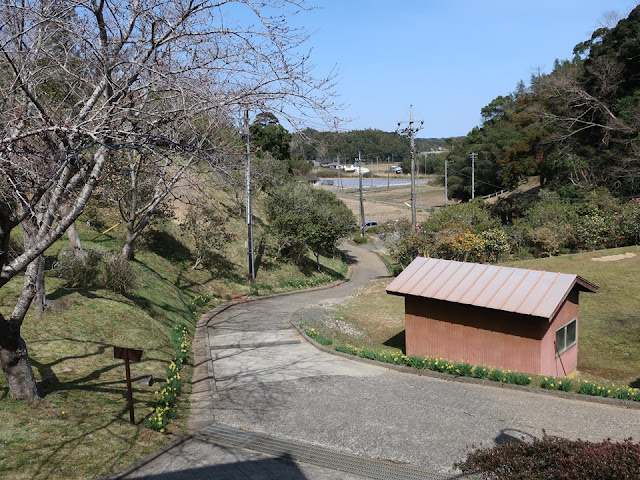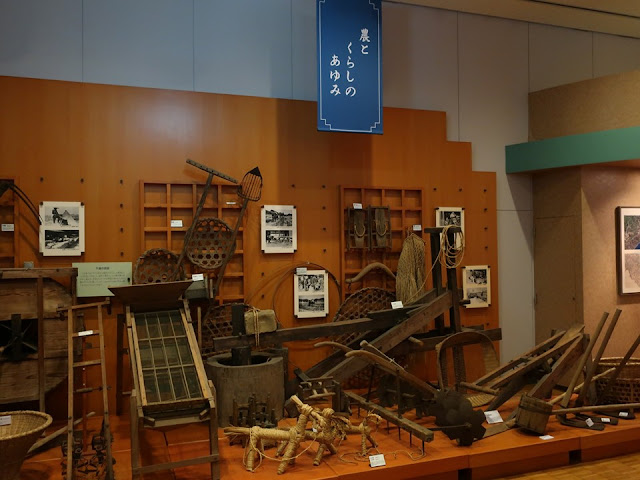This museum is located in Chiba prefecture
next to Tokyo.
Y. Ohara(1797-1858) improved productivities
of agriculture and livelihood in this region. However, he was accused by the shogunate, because
he was not a government officer but he built a large school and initiated a cooperative
which was the first one in the world. The shogunate ordered him to break down
the school and dissolve the cooperative. The villages got run-down again and he
committed suicide (hara-kiri) at graveyard.
The villagers and the disciples appreciated and
praised him, and they maintained the site and made it his memorial park. It has his house, the memorial museum and so on. He was really respected.
This museum is run by Asahi city and the
first floor of the museum is the folklore exhibition room. I took photos under
approval of the museum.
千葉県の九十九里浜、旭市にある博物館です。
大原幽学(1797-1858)は、当地の農業の改革、生活の改革を指導し、生活水準を向上させました。しかし、幕府から、大規模な教導所の建設が農民に不似合いだとか、世界初の農業協同組合といわれる「先祖株組合」は領主の管理への関与だとか指摘され、教導所の取り壊しや組合の解散を命じられました。村々はもとの荒れた生活にもどってしまい、幽学は、墓地で自刃しました。
でも、門人や村人達は、幽学を讃えて「大原幽学遺跡史跡公園」を作りました。公園には幽学の旧宅などとともに記念館があります。幽学が如何に人々から感謝されいたかが分かります。記念館の一階が郷土展示室になっています。許可を申請し、撮影しました。
The exhibition room has a tidy ambience like Ohara. His reforms are shown understandably.
For example, the farmers stopped gambling due
to his advice. The gangsters who run the gambling house had unreasonable grudges,
and attacked his school.
幽学の人生のように、きちんとした雰囲気がただよう展示室です。彼の指導によって、農民が博打をしなくなり、困った博徒が教導所を襲撃する事件もあったそうです。幽学の改革が丁寧に説明されています。
These frugal things are his tableware which were purchased in a cheap price because of group buying of his cooperative.
組合で安く共同購入した食器類。質素です。
Someone wears Ohara’s travel goods. I like the hat.
幽学の旅の道具。遺品を身につけた写真が展示されてます。道中笠がいいですね。
His house was maintained by his disciples. The roof was a thatched one when he lived.
教導所跡から見た幽学の旧宅。門人達によってしっかりと維持されてきました。江戸時代は茅葺きだったそうです。
This farmer’s house was moved to the park. One of his disciples lived, and Ohara advised the functional layout.
移築された門人の農家。幽学が機能的なレイアウトを指導しています。
The way to the park: it is in a peaceful rural area. He instructed an effective zoning which remains even until now.
公園へのアプローチ。のどかな農村地帯にあります。幽学が考えた作業性が良い地割りが残っています。
Local history and folklore exhibition room、郷土展示室
There is a rope at the entrance of the room which is hung at the border of a village in order to stop bad things such as diseases from coming into. It is made by new straw and is hung in January or February.
Very unique things are attached to the rope. The straw octopus absorbs demons. The dice and the cards prevent people from gambling. Gambling seems to be a disease in this area.
郷土展示室の入り口には、辻切りの縄が張られています。正月から二月ぐらいに、新しい藁で作って、集落の入口に吊るし、疫病が入って来るのを防ぎます。
ユニークなのがその形。悪霊を吸い取るタコ、博打の悪習を戒めるサイコロ。花札や将棋のコマもありました。藁で蛇や人形を作る地域が多いと思いますが、博打も悪い病と考えいるようです。
Ancient period、古代
当地で育てられた古代米が藁付きで展示されています
Medieval period、中世
Kaburagi clan (samurai) and Katori Shrine were powerful in this area.
鏑木氏や香取神宮が大きな力を持っていました
Edo period (1603~1868)、江戸時代
The wooden sword which is 3.8m long was offered to the Ohyama Shrine in Kanagawa prefecture in 1763. More than two hundred people signed on it. After visiting Ohyama, people brought it to the village as a talisman. They probably had a banquet with this sword.
The picture lower left is Edo people who bring a wooden sword to Ohyama(Gallery of Edo Shitamachi Traditional Crafts). This custom began after Y. Minamoto offered a sword and prayed to beat his rival.
神奈川県の大山阿夫利神社神社に奉納した木刀。1763年6月に奉納した物で、3.8m、200名以上の名前が記されています。奉納後は持ち帰って護符にしたといいますから、大宴会だったでしょう。
左下は、木刀を担いで大山に参詣する江戸っ子の絵です(江戸下町伝統工芸館)。平家打倒を願う源頼朝の太刀の奉納にちなんで、人気のイベントになりました。
There was a large lake in this area. People reclaimed it and established 18 villages. The fields were obtained after big efforts.
江戸初期には、椿海という大きな湖があったのですが、その後、干拓を進め18の村を作りました。苦労の末にできた土地です。
The population decreased in the early 19th century. In the region near Tokyo, the villages got run-down because of a bad harvest and a bad security. Villagers went out to work, so the population declined. Ohara improved the villages under the difficult condition.
幕末には、関東一円で農村が荒廃しました。浪人や無宿者が増えて治安が乱れ、その上に不作が続きました。農村では出稼ぎが増え、人口が減ってしまいました。その状況で、大原幽学は村を立て直したのですね。
There was the battle among gangsters at that time. It was the theme of the film and the storytelling.
博徒の争いがあり、「天保水滸伝」として講談や映画の題材になっています。笹川の繁蔵親分は、180kgの力石を息栖神社に納めています。
Reference: Kamisu history and folklore museum、神栖市歴史民俗資料館
Life after the Meiji period (1868-1912)、明治以降の暮らし
Tableware, furniture and so on are exhibited.
たくさんの民具が展示されています。
Women were important workforce of the manual agriculture and housework. Children were together with family members before kindergartens were built.
女性は大切な労働力。子どもも一緒にいました。家族の風景ですね。
These clothes are for a baby. It was used while holding, feeding and sleeping until 1950’s. The colorful baby clothes on the right were made by the grandmother. People sent it to the newborn with praying for their healthy growth.
抱っこや授乳、寝間着にもなったおくるみはんてんとちゃんちゃんこ(左)は、昭和30年頃まで使われていました。展示品は初孫の誕生祝いに祖母が縫ったものだそうです。産着(右)は、生まれて初めて着る晴れ着で、子どもの成長を祈りました。
These are sake (alcohol) barrels for celebrations such as a wedding ceremony.
婚礼などの祝酒で使われた祝樽です。漆を塗っていない素朴さが気に入りました。
People have enjoyed lives even in the
difficult era, I think.
どんな時代でも、人々の生活の中には楽しみがありますね。
Visited in March, 2021
Official
website: http://www.city.asahi.chiba.jp/yugaku/
(in Japanese), accessed in March, 2021
Previous post (Local museum near there):
Kamisu history and folklore museum、神栖市歴史民俗資料館
Next post (Records of foreigners who visited Japan
before modernization、幕末期の来日外国人が見た日本):
Remnants of Days Past: A Journey through Old Japan、逝きし世の面影






















Comments
Post a Comment